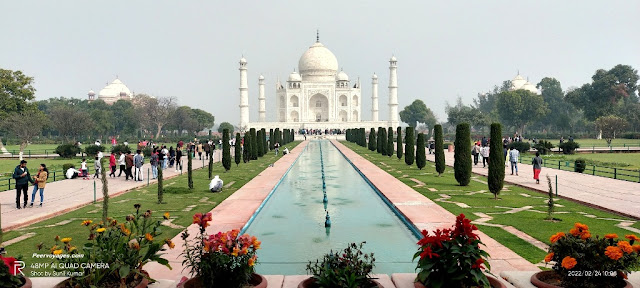Nestled on the banks of the Yamuna River in Agra, India, stands a testament to love that transcends centuries: the magnificent Taj Mahal. This ivory-white marble mausoleum is not just a building; it's a symbol of eternal love and architectural brilliance that has captured the hearts of millions around the globe.
A Tale of Love and Legacy
The story of the Taj Mahal begins with Emperor Shah Jahan, who ruled the Mughal Empire from 1628 to 1658. His love for Mumtaz Mahal, his favourite wife, was legendary. Mumtaz Mahal, whose name means "the chosen one of the palace," was not just a queen but also Shah Jahan's confidante and advisor.
Tragically, Mumtaz Mahal passed away during childbirth in 1631. Devastated by her death, Shah Jahan decided to honour her memory in a way that the world had never seen before. He commissioned the construction of a grand mausoleum that would serve as her final resting place and a symbol of his undying love for her.
Architectural Marvels Unveiled
The task of bringing Shah Jahan's vision to life fell upon the shoulders of a team of skilled architects, artisans, and craftsmen. Led by Ustad Ahmad Lahauri, the chief architect, the construction of the Taj Mahal began in 1632 and took over 22 years to complete.
The design of the Taj Mahal is a fusion of various architectural styles, including Persian, Islamic, Ottoman Turkish, and Indian. The central dome, flanked by four minarets, is the focal point of the structure. The intricate marble inlay work, featuring floral motifs, calligraphy from the Quran, and precious gemstones, reflects the finest craftsmanship of the Mughal era.
Symbolism and Significance
Beyond its stunning beauty, the Taj Mahal holds deep symbolic significance. It is not just a mausoleum but a metaphor for eternal love and the transient nature of life. The symmetry and balance in its design represent the harmony and order of the universe, while the garden surrounding the mausoleum symbolises paradise in Islamic tradition.
Moreover, the Taj Mahal is a UNESCO World Heritage Site and a global icon of cultural heritage. Its preservation and conservation efforts highlight the importance of safeguarding our shared history for future generations to cherish.
Legacy Through the Ages
Over the centuries, the Taj Mahal has stood as a timeless witness to countless tales of romance, resilience, and reverence. It has inspired poets, artists, and travellers from every corner of the world, leaving them awestruck by its grandeur and grace.
Today, the Taj Mahal continues to be a symbol of India's rich cultural heritage and a testament to the enduring power of love. As visitors gaze upon its marble facade, they not only admire its architectural splendour but also feel the poignant story of Shah Jahan and Mumtaz Mahal echoing through the corridors of time.
In essence, the Taj Mahal is more than just a monument; it is a living legacy that reminds us of the boundless beauty that exists in both love and artistry, transcending the barriers of time and space.
Visiting the Taj Mahal is a memorable experience, and there are certain things you should keep in mind to make the most of your tour while respecting the site's cultural significance and regulations. Here's a list of dos and don'ts during your Taj Mahal tour:
Respect the Dress Code: Wear modest clothing that covers your shoulders, arms, and knees. This is not just a courtesy but also a requirement at many religious and historical sites in India.
Carry Valid Identification: Bring a government-issued ID, such as a passport or driver's license, as it may be required for ticket purchase and entry.
Arrive Early: The Taj Mahal is most serene and less crowded in the early morning hours. Plan to arrive as soon as it opens to avoid long queues and experience the monument in a peaceful atmosphere.
Follow Photography Rules: You can take photographs outside the main mausoleum, but inside photography is not allowed. Respect the guidelines and refrain from using drones or selfie sticks, as they can be disruptive.
Listen to Guides: Consider hiring a licensed tour guide who can provide historical insights and interesting facts about the Taj Mahal. They can enhance your experience and help you appreciate the monument's significance.
Stay Hydrated: Agra can get hot, especially during the summer months. Carry a water bottle to stay hydrated during your tour.
Dispose of Trash Properly: Use designated bins for trash disposal to maintain the cleanliness of the site and protect the environment.
Don't:
Touch or Scratch the Marble: The Taj Mahal's marble surfaces are delicate and susceptible to damage. Refrain from touching or scratching the walls, as this can cause erosion over time.
Bring Prohibited Items: Avoid carrying items such as weapons, sharp objects, large bags, or food inside the monument complex. These are typically not allowed and can be confiscated at security checkpoints.
Engage in Loud or Disruptive Behavior: Maintain a respectful demeanour and avoid loud conversations, shouting, or disruptive behaviour that can disturb other visitors and detract from the solemnity of the site.
Smoke or Litter: Smoking is prohibited within the Taj Mahal complex, and littering is strictly prohibited. Keep the surroundings clean and refrain from smoking in designated non-smoking areas.
By following these dos and don'ts, you can have a respectful, enjoyable, and memorable tour of the Taj Mahal while preserving its cultural and historical integrity for future generations.
we offer north India tour packages at affordable price
Whatsapp +919927538763 +919045428672
Email- peervoyages@gmail.com
read more blogs about India Travel




No comments:
Post a Comment